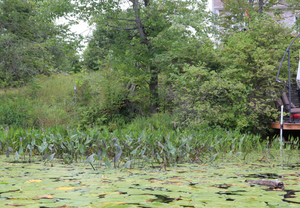by Nathaniel Sneyd-Dewar, Riparian Habitat Restoration Intern
Shoreline properties are located on the frontline of climate change as many environmental functions and processes are pronounced at this critical area for biodiversity and the water cycle. Shoreline properties exist in the riparian area (within 30m of the shoreline), which is a vital region for ecosystem and environmental resilience and can be considered the “ribbon of life”. The immense diversity and connection between land and water in this area has a pronounced environmental effect as there is diverse and constant activity in the water cycle. Supporting riparian landowners is an area that needs addressing as there is often a lack of resources and analysis of shoreland properties. By understanding the ecological flows of a property, landowners can see what alterations they can make or what signs they can watch out for as climate change events impact their community.

Climate Change Expectations
Changes to climate patterns will occur in increasingly unpredictable patterns. The burning of fossil fuels and the increase in development has impacted the function and health of ecosystems, with species declines or outright extinction of many plants and animals. Reducing the development impact of riparian properties is a critical way to build adaptive capacity and counteract the momentum of climate change impacts. There are individual and combined effects from climate factors (precipitation, temperature, wind, etc.) and landscape factors (slope, soil types, plant coverage, developed area, etc.) that need to be considered.
The increase in air and water temperatures that will come with climate change will alter the magnitude and seasonality of precipitation and run-off patterns. Riparian ecosystems have many functions that influence chemical, biological, and physical elements regulating water, nutrients, sediment, and other flows between terrestrial and aquatic environments. An increased prevalence, duration, and extent of impacts from floods and droughts make strengthening riparian ecosystems critical to protect from soil run-off and bank erosion. With more storm events and variable weather patterns, planting native species of various heights, strengths, and functions is of the utmost importance to promote resilient support for soils across shoreline property environments. Utilizing free resources such as the Canada-wide Native Plant Database can help individuals pick suitable and preferred native plant species to add to their property.
Shoreline Property Impact and Solutions
The ideal riparian ecosystem has a loamy soil (mix of sand, silt, and clay) with significant organic matter and a variety of native species which actively cycle water and soil nutrients across soil layers. A healthy riparian ecosystem can exist even on developed shoreline properties but requires careful design to minimize the impact on normal ecosystem function to optimize ecosystem function for climate change resilience. Planting a mix of species resilient across the spectrum of hydrological conditions will prove advantageous to flood and drought uncertainty. Ensuring hardscape development is minimal, depending on your accessibility needs, and any development project considers water flows and aims to allow for soil infiltration and plant growth support is ideal. Having a diverse array of native plant species of various ages and types (trees, shrubs, wildflowers, grasses, etc.) is also advantageous for a property’s ecological success and climate change resilience.
A number of free resources exist to assist waterfront property owners in increasing the climate resiliency of their shoreline. Be sure to check out our Climate Change Education Toolkit, as well as our free resources page for webinars, stewardship guides, planting plan documents, handouts, and more. This climate change education toolkit is generously funded by The Catherine and Maxwell Meighen Foundation.
